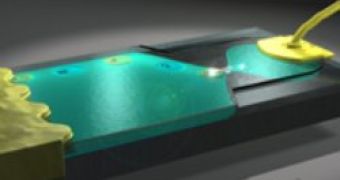Qubits are single units of quantum information, based on the fact that quantum states can be interpreted as information, which can be compressed in a state and stored on a smaller number of states. Most researchers seem to think photons will be the next step in computing technology, creating the supercomputers of the future.
But a new development shows that the electron might have just caught up with the photon as a possible data carrier for the next generation of supercomputers. A team of researchers have recently proved the ability to control a current so precisely that they can transmit electrons one at a time, which may be used as a key element in building a quantum chip.
Physicist Christian Glattli and his team at L'?cole Normale Sup?rieure in Paris, have successfully created a device that emits single electrons through a conducting medium called a two-dimensional electron gas (2DEG), each electron's passing taking not more than a nanosecond.
The fact that the electrons are not disturbed as they pass one by one can make them act as quantum bits, or qubits, more elaborate versions of the individual data bits in conventional computer systems. The scientists achieved this by creating a quantum dot that only allows individual electrons to pass through the 2DEG one at a time whenever it receives a tickle of electricity.
However, more research is needed to begin to control the movement of qubits and Glatti says "he difficulty of such control will be overcoming the signal noise generated when single electrons are emitted quickly."
Another vital component of a quantum computer will be an electron detector to receive the qubits, which requires a 10-fold increase in speed for single-electron detectors, but it will also require a lot of work, in the hopes of creating quantum computer applications that use electrons.

 14 DAY TRIAL //
14 DAY TRIAL //